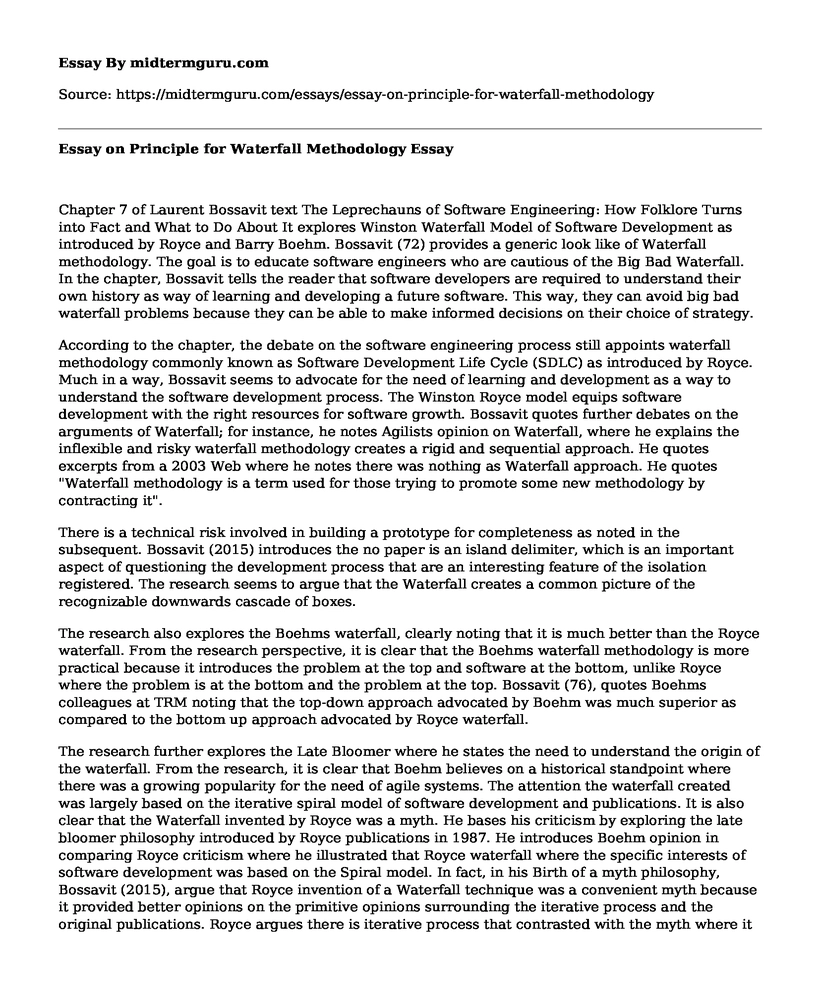Chapter 7 of Laurent Bossavit text The Leprechauns of Software Engineering: How Folklore Turns into Fact and What to Do About It explores Winston Waterfall Model of Software Development as introduced by Royce and Barry Boehm. Bossavit (72) provides a generic look like of Waterfall methodology. The goal is to educate software engineers who are cautious of the Big Bad Waterfall. In the chapter, Bossavit tells the reader that software developers are required to understand their own history as way of learning and developing a future software. This way, they can avoid big bad waterfall problems because they can be able to make informed decisions on their choice of strategy.
According to the chapter, the debate on the software engineering process still appoints waterfall methodology commonly known as Software Development Life Cycle (SDLC) as introduced by Royce. Much in a way, Bossavit seems to advocate for the need of learning and development as a way to understand the software development process. The Winston Royce model equips software development with the right resources for software growth. Bossavit quotes further debates on the arguments of Waterfall; for instance, he notes Agilists opinion on Waterfall, where he explains the inflexible and risky waterfall methodology creates a rigid and sequential approach. He quotes excerpts from a 2003 Web where he notes there was nothing as Waterfall approach. He quotes "Waterfall methodology is a term used for those trying to promote some new methodology by contracting it".
There is a technical risk involved in building a prototype for completeness as noted in the subsequent. Bossavit (2015) introduces the no paper is an island delimiter, which is an important aspect of questioning the development process that are an interesting feature of the isolation registered. The research seems to argue that the Waterfall creates a common picture of the recognizable downwards cascade of boxes.
The research also explores the Boehms waterfall, clearly noting that it is much better than the Royce waterfall. From the research perspective, it is clear that the Boehms waterfall methodology is more practical because it introduces the problem at the top and software at the bottom, unlike Royce where the problem is at the bottom and the problem at the top. Bossavit (76), quotes Boehms colleagues at TRM noting that the top-down approach advocated by Boehm was much superior as compared to the bottom up approach advocated by Royce waterfall.
The research further explores the Late Bloomer where he states the need to understand the origin of the waterfall. From the research, it is clear that Boehm believes on a historical standpoint where there was a growing popularity for the need of agile systems. The attention the waterfall created was largely based on the iterative spiral model of software development and publications. It is also clear that the Waterfall invented by Royce was a myth. He bases his criticism by exploring the late bloomer philosophy introduced by Royce publications in 1987. He introduces Boehm opinion in comparing Royce criticism where he illustrated that Royce waterfall where the specific interests of software development was based on the Spiral model. In fact, in his Birth of a myth philosophy, Bossavit (2015), argue that Royce invention of a Waterfall technique was a convenient myth because it provided better opinions on the primitive opinions surrounding the iterative process and the original publications. Royce argues there is iterative process that contrasted with the myth where it begins with the starting down and road to infamy.
Arguably, Royce conceptualization on the waterfall development created an insight to software engineering that the software planning required perfect assembly of ideas into stages. Boehm approach seems to elaborate Royce ideas critically appreciating the need to organize software development into finite stages that were interrelated to each other. Either way, the two waterfalls methodologies ignite the need for a highly dynamic process and change that is inevitable. The waterfall cycle is a critical approach for managing any large software system.
Works Cited
Bossavit, Laurent. The Leprechauns of Software Engineering: How Folklore Turns into Fact and
What to Do About It. , 2015. Print.
Cite this page
Essay on Principle for Waterfall Methodology. (2021, Jun 02). Retrieved from https://midtermguru.com/essays/essay-on-principle-for-waterfall-methodology
If you are the original author of this essay and no longer wish to have it published on the midtermguru.com website, please click below to request its removal:
- Discussion Questions on Human-Machine Interface (HMI) - Paper Example
- Essay on Informational Approach in Measuring Organizational Effectiveness
- Importance of Electronic Health Records in Improving Healthcare - Research Paper Example
- Ethics and Sustainability Ford Motors Company - Paper Example
- Research Paper on Teamwork
- Haiti Earthquake 2010 - Essay Sample
- Strengths and Weaknesses of Professional Accountability in Nursing - Essay Sample







